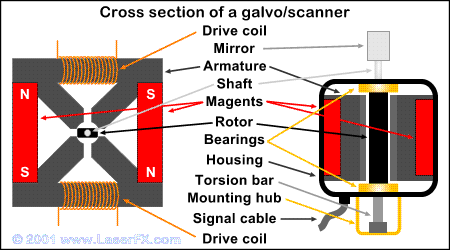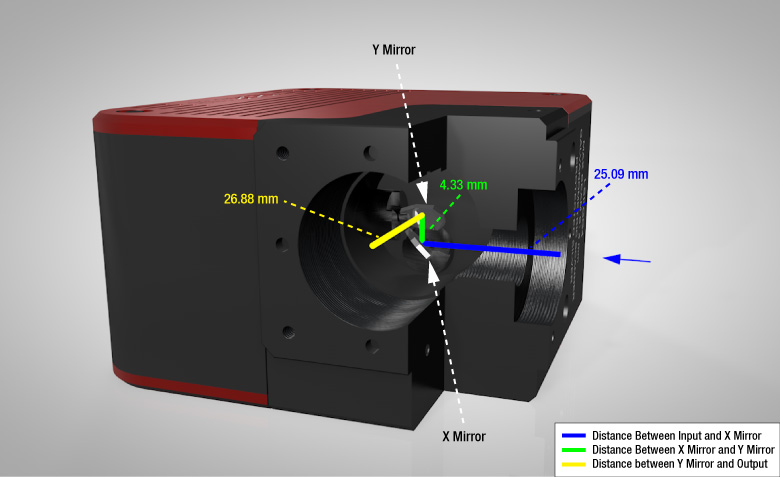Recognizing the Modern Technology Behind the Galvanometer Scanner for Accurate Readings
Recognizing the Modern Technology Behind the Galvanometer Scanner for Accurate Readings
Blog Article
Key Applications of a Galvanometer Scanner in Various Scientific Research Fields
Galvanometer scanners have come to be important to various scientific research study fields, providing improved accuracy in applications ranging from biomedical imaging to ecological monitoring. As we explore the multifaceted applications of galvanometer scanners, it comes to be noticeable that their effect prolongs far past mere technical capabilities, raising inquiries concerning their future potential in emerging study locations.
Biomedical Imaging

In confocal microscopy, galvanometer scanners assist in the procurement of images with improved resolution and contrast, enabling researchers to envision mobile parts in vivo. The ability to quickly catch multiple focal aircrafts enhances the three-dimensional repair of tissues, giving critical understandings into their architecture and function.

Furthermore, the rapid scanning capabilities of galvanometer systems add to improvements in vibrant imaging applications, such as checking mobile actions to stimuli. Galvanometer scanners are crucial tools in the area of biomedical imaging, progressing research study and professional diagnostics through their accuracy and effectiveness.
Product Processing
Accuracy in material handling is crucial for attaining premium lead to numerous industrial applications (galvanometer scanner). Galvanometer scanners play a crucial function in boosting this accuracy by making it possible for quick and exact motion control during the handling of materials such as ceramics, polymers, and metals. These gadgets help with methods like laser cutting, engraving, and welding, which need finely-tuned modifications to ensure ideal outcomes
In laser cutting, as an example, galvanometer scanners enable intricate layouts to be implemented with high fidelity, lowering waste and improving manufacturing effectiveness. The fast activity capabilities make it possible for fast modifications in the laser beam of light path, which is important for preserving constant cutting high quality throughout differing material densities. Likewise, in laser welding applications, the accuracy offered by galvanometer scanners makes sure strong joints with minimal thermal distortion, thereby boosting structural stability.
In addition, the adaptability of galvanometer scanners to different laser types and wavelengths further widens their utility in product processing. Their capability to operate in tandem with innovative software program for real-time monitoring and control adds an additional layer of elegance, making it possible for producers to achieve precise specs tailored to certain applications. Thus, galvanometer scanners are important beforehand the abilities of product processing modern technologies.
Optical Characterization
In the realm of optical characterization, the role of galvanometer scanners becomes significantly considerable as they promote the analysis of numerous optical residential properties with high precision. These tools make it possible for accurate control of laser light beams, enabling scientists to systematically probe products at multiple angles and regularities. This ability is vital for view identifying the refractive index, absorption coefficient, and spreading buildings of varied materials.
Galvanometer scanners are especially efficient in strategies such as optical coherence tomography (OCT) and laser-induced fluorescence (LIF), where rapid scanning is vital. By achieving high-speed modulation of the laser placement, galvanometer scanners boost the temporal resolution of these methods, resulting in enhanced imaging and evaluation. Furthermore, they enable the expedition of intricate interactions in between light and issue, which is essential for comprehending material behaviors under various conditions.
Furthermore, the assimilation of galvanometer scanners with spectroscopic techniques broadens their utility, permitting thorough spectral analysis throughout a large range of wavelengths. This convenience makes them crucial devices in areas such as products scientific research, biomedical research, and nanotechnology, where in-depth optical characterization is vital for progressing knowledge and development.

Laser Micromachining
The development of laser micromachining has actually reinvented producing processes, making it possible for the creation of intricate frameworks with unmatched accuracy. This strategy uses high-intensity laser light beams to exactly remove product from a substratum, making it feasible to produce micro-scale elements that are critical in various sectors. The application of galvanometer scanners in laser micromachining enhances the effectiveness and accuracy of this process by enabling exact and quick beam positioning.
Galvanometer scanners help with the dynamic control of laser beam of lights, enabling complicated patterns to be engraved or reduced with high integrity. Their quick response times and high-resolution abilities enable for the control of laser pulses, which is vital for accomplishing the wanted material residential properties and surface coatings. This modern technology is especially beneficial in fields such as electronics, where the miniaturization of elements is necessary for efficiency enhancement.
Additionally, laser micromachining is progressively being employed in the medical field for making accuracy instruments and implants. The combination of laser technology and galvanometer scanning not only simplifies manufacturing workflows however also decreases waste and improves overall material usage, making it a lasting choice for modern-day production challenges.
Environmental Monitoring
Environmental monitoring has actually ended up being progressively crucial in handling the health and examining of ecosystems and metropolitan atmospheres. The combination of galvanometer scanners in this area enables precise, rapid, and effective information collection, helping with better decision-making processes. These scanners are skilled at routing laser light beams or sensing units across various terrains, permitting high-resolution mapping of ecological parameters such as air high quality, soil make-up, and water air pollution.
In air quality monitoring, galvanometer scanners can be used to analyze particulate matter and gaseous contaminants, giving real-time data that educates public wellness initiatives. For water high quality evaluations, these scanners can help in detecting contaminants and gauging physical specifications, therefore ensuring compliance with environmental regulations. In addition, in remote sensing applications, galvanometer scanners enhance the ability of satellite and drone systems to capture in-depth photos and data of huge locations, identifying environmental changes and anthropogenic influences.
The versatility and accuracy of galvanometer scanners make them essential tools in ecological surveillance, contributing substantially to lasting development efforts and the security of natural deposits. As the demand for reliable environmental monitoring grows, the duty of these advanced devices will definitely increase even more.
Final Thought
In recap, galvanometer scanners offer as important devices across numerous scientific research study domains. Their application in biomedical imaging improves the accuracy of methods crucial for mobile visualization and diagnostics. In material processing, these scanners facilitate sophisticated laser cutting and welding procedures, ensuring marginal distortion. Their duty in ecological monitoring underscores the relevance of exact data collection in resolving public health and environmental challenges. The convenience and efficiency of galvanometer scanners remain to drive advancements in these essential fields.
In Our site laser welding applications, the precision supplied by galvanometer scanners makes certain strong joints with marginal thermal distortion, thereby improving structural stability.
Moreover, the adaptability of galvanometer scanners to various laser types and wavelengths additionally widens their utility in product handling. By accomplishing high-speed inflection of the laser setting, galvanometer scanners enhance the temporal resolution of these techniques, leading to improved imaging and evaluation. The application of galvanometer scanners in laser micromachining boosts the efficiency and precision of this process by enabling precise and rapid light beam positioning.
Galvanometer scanners facilitate official source the dynamic control of laser beam of lights, making it possible for complex patterns to be engraved or cut with high fidelity.
Report this page